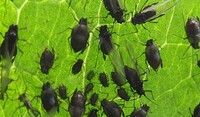
A wet start... a round up from our Senior Agronomy Managers

With most of October, large parts of November and the majority of December bringing persistently heavy rainfall, winter drilling and herbicide applications have been somewhat difficult – to say the very least.
So, as we get ready to kick-start our Spring 2024 crop protection blog, we find out from our Senior Agronomy Managers, Holly Pratt and David Griffiths, how crops are looking in their respective halves of the UK and discuss a few of the headline topics to start thinking about as the spring draws ever closer.
Holly Pratt
Senior Agronomy Manager, East
It’s a really mixed bag in terms of how crops are looking in the eastern half of the UK. Where crops were drilled earlier, or in areas where the weather wasn’t vile for the entirety of the winter months, crops haven’t been too badly affected, with some good-looking fields that received herbicide applications on time and in full.
Unfortunately, those crops which weren’t drilled until into November or December aren’t looking anywhere near as good, with many wheats only just at the first true leaf stage and well behind where they ideally should be. To compound the situation, a significant proportion of these later drilled crops haven’t received an herbicide treatment, leaving them increasingly susceptible to competition from blackgrass, ryegrass and broad-leaved weeds.
It’s maybe a little too early to start commenting on disease levels, but a couple of people I’ve spoken to recently have expressed some mild concern that even those crops which are currently looking nice and clean could still come under severe pressure later in the spring. We have no idea how the weather will unfold over the next few months, and as such they are cautious about letting any signs of disease going untreated as this could lead to a tricky period of ‘firefighting’ later in the spring. Fungicide discussions are therefore ongoing with growers in the hope that a solid plan can be put in place sooner rather than later.
With all that said, conditions have definitely improved over the past week or two, with noticeably more field work being carried out as a result.
It’s certainly going to be an interesting year with plenty of challenges, but we’re here to help and urge growers and agronomists to pick up the phone if there’s anything they’d like to discuss. For example, ADAMA’s range of herbicides which includes the likes of ANTHEM (pendimethalin 400 g/l), TOWER (chlorotoluron 250 g/l + diflufenican 40 g/l + pendimethalin 300 g/l) and HURRICANE (diflufenican 500 g/l), all have really flexible application timings and could prove very useful in such a topsy-turvy season.
And of course, our multi-site fungicide ARIZONA (500 g/l folpet) will once again prove critical to ensuring crops remain clean from the very outset and as they progress through their spring growth stages.
David Griffiths
Senior Agronomy Manager, West
It’s a similar situation in the western half of the UK where conditions vary hugely. In general, the southern half of my territory has been less severely affected by the wet conditions compared to the north, but there’s a really wide range of scenarios for growers and agronomists to deal with.
Some crops – predominantly those which were drilled in September – are looking very promising, but there are some marginal crops that are going to need careful management to reach their potential and to keep costs under control.
Disease levels seem low at the moment, with January’s colder snap slowing things down a little, but there are some cereals that have yet to receive a herbicide application: in in some cases expectations for what can be achieved will need to be managed.
In the last few weeks there’s been an increase in field work, with some winter wheat going in on lighter land using more ‘traditional’ establishment techniques. It's worth noting here that any crops sown on or after 1st February are officially classified as spring crops, irrespective of the variety being drilled. This means that crops drilled after this cut-off can only be treated with products labelled as being approved for spring-sown crops.
This could cause some confusion, especially where spring wheat hasn’t typically been grown before, so it’s important to understand the rules to make sure herbicide programmes don’t fall foul of the transition from winter to spring cropping – if in doubt please don’t hesitate to get in touch with your nearest ADAMA agronomy manager: https://www.adama.com/uk/en/adama-representatives
The transition from winter to spring cropping will mean that some herbicides can’t be used on spring wheat, even if the actives themselves may be used via other products. Fortunately, there are still plenty of options available to ensure spring-sown cereals remain protected and ahead of the curve in terms of weed competition. The herbicides Holly has already mentioned (HURRICANE, TOWER and ANTHEM) have flexible application options and are proven to offer value for money as a reliable means of controlling some of the key grass and broad-leaved weeds. However, growers should be aware that although ANTHEM (pendimethalin 400 g/l) can be used on spring barley, it is no longer approved for use on wheat drilled from 1st February onwards.
It’s also worth noting that slug pressure is expected to be significant this year, especially as rising soil temperatures bring slugs to the soil surface where they are likely to find plenty of new seed and young seedlings on which to graze. The timely application of a high quality molluscicide will therefore be of critical importance as will the efficacy and quality of the slug pellets being applied. Tune in next week to find out more how and when our Gusto IRON slug pellets can help in this particular battle.


